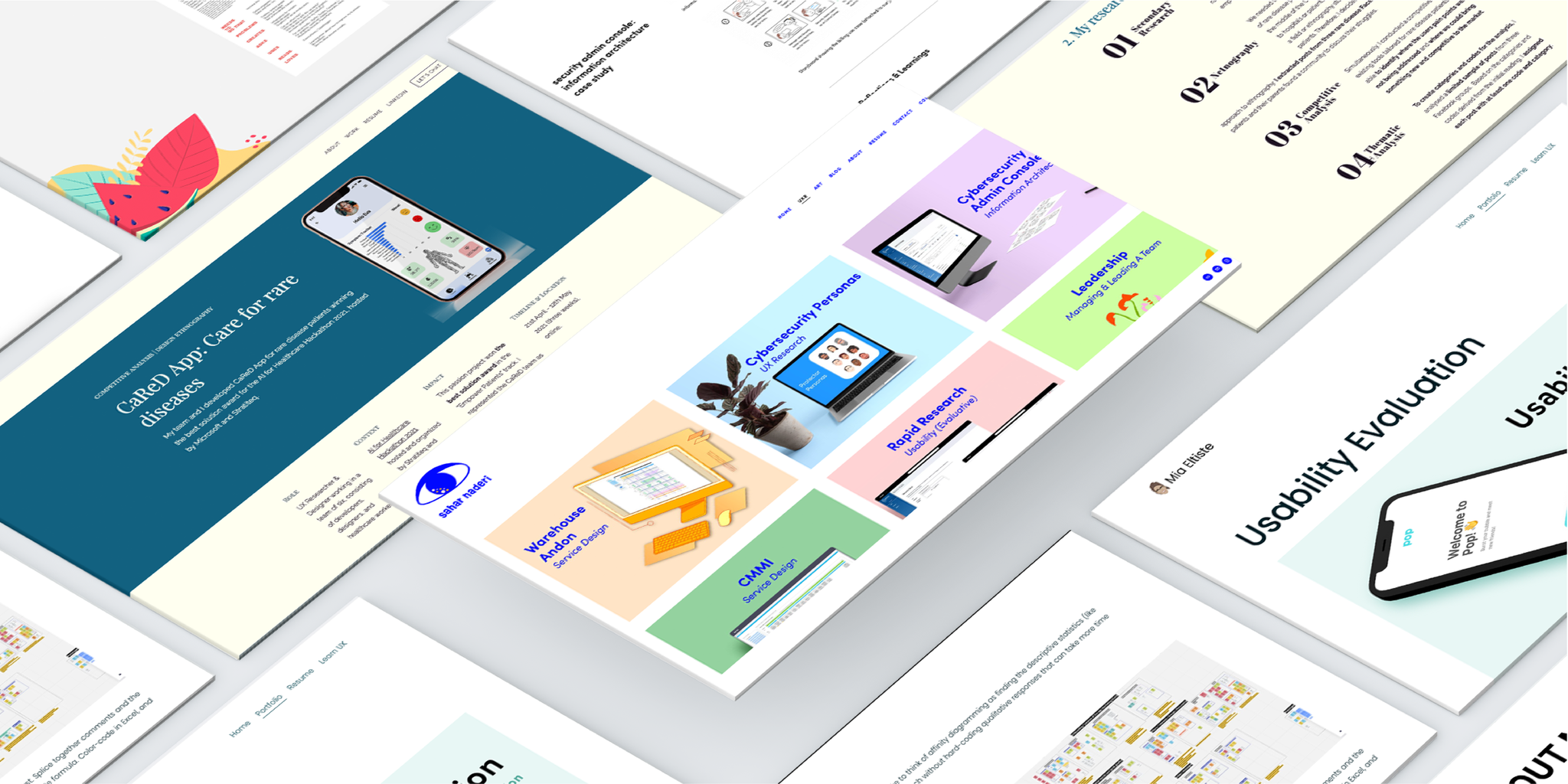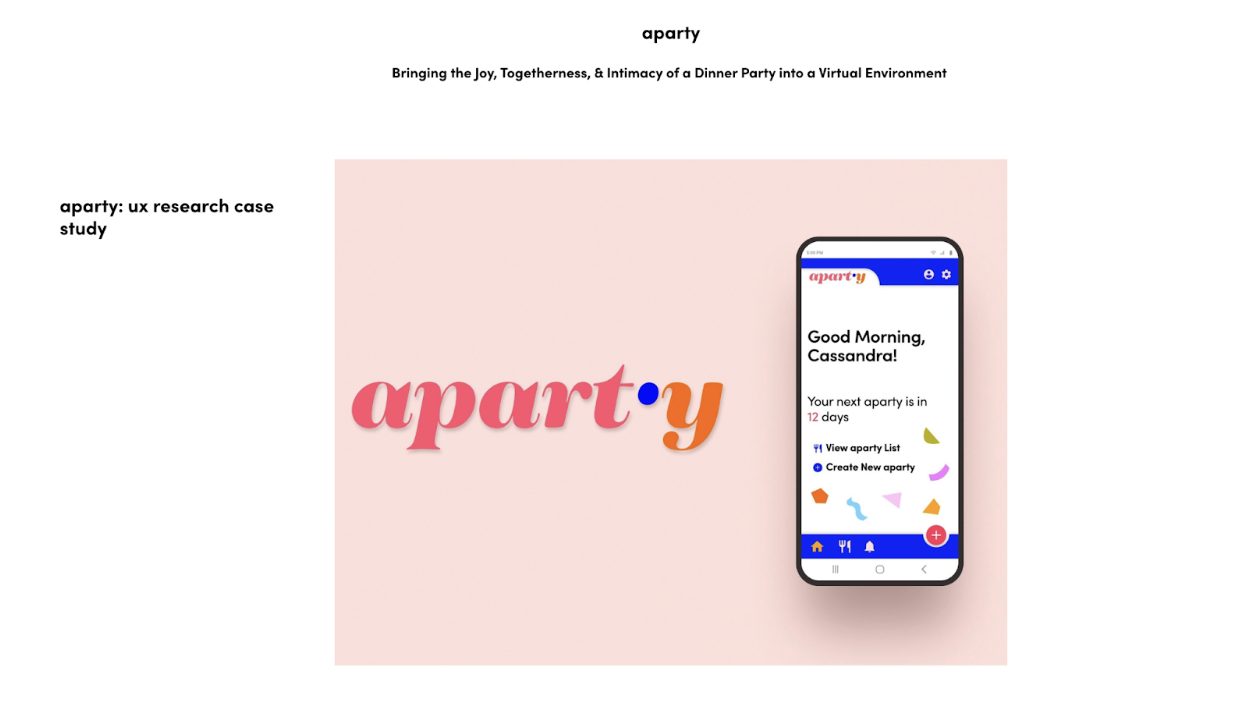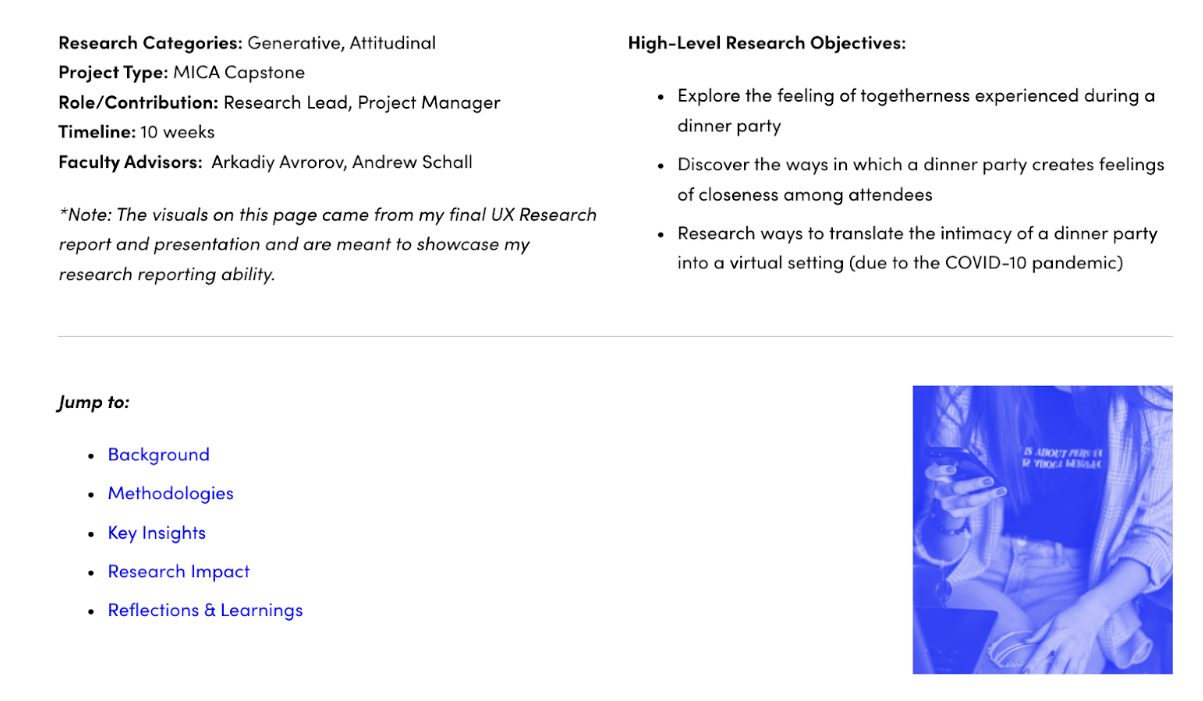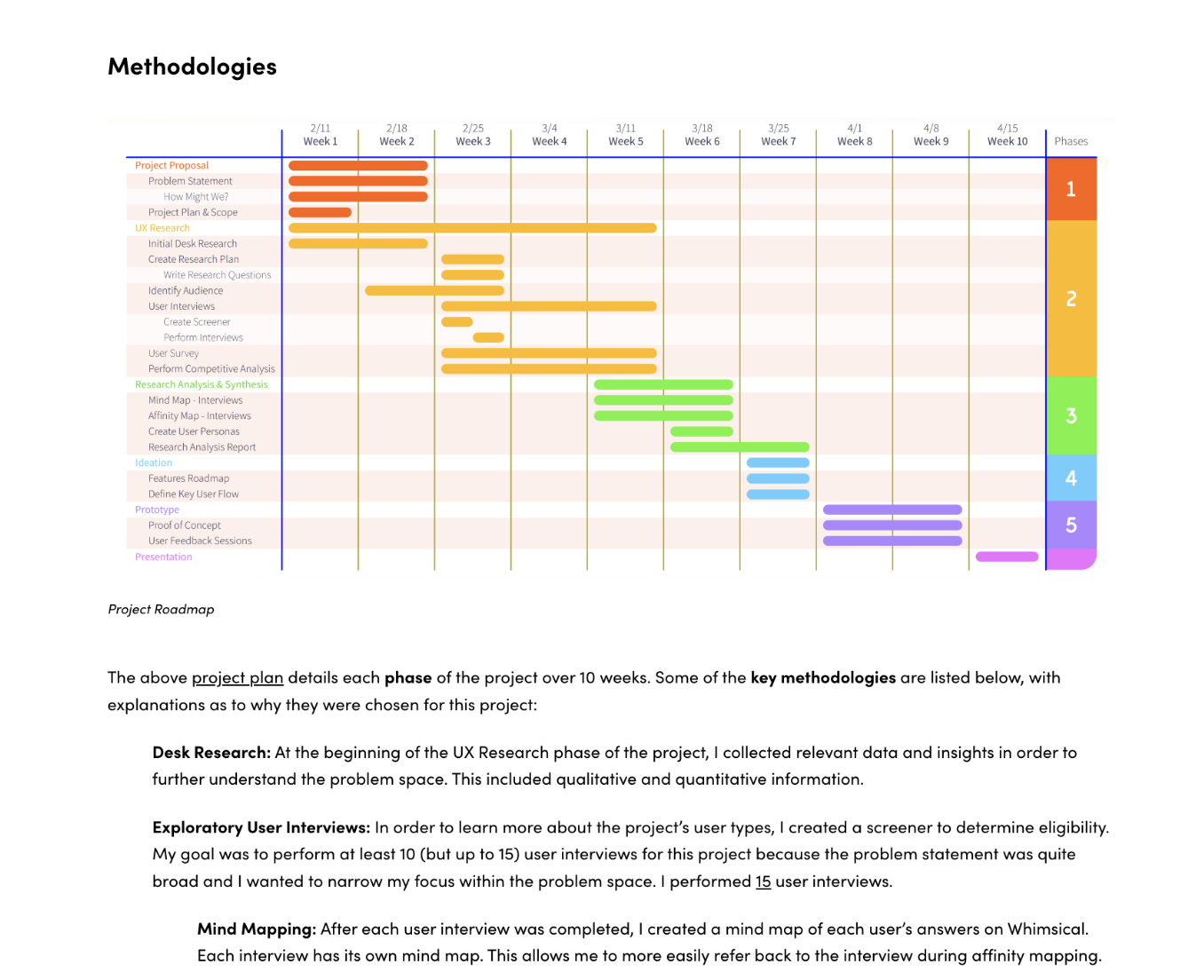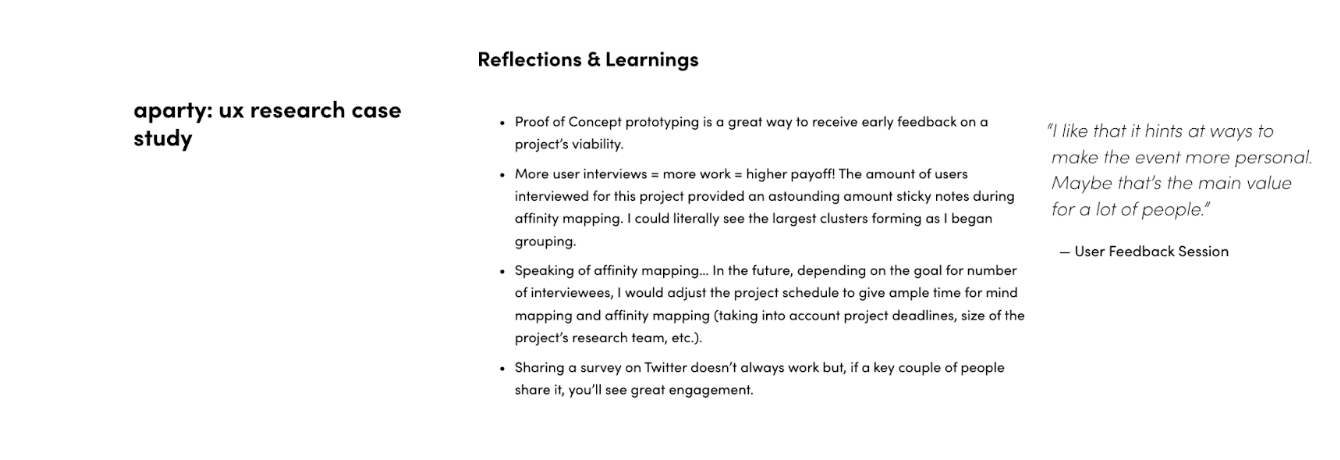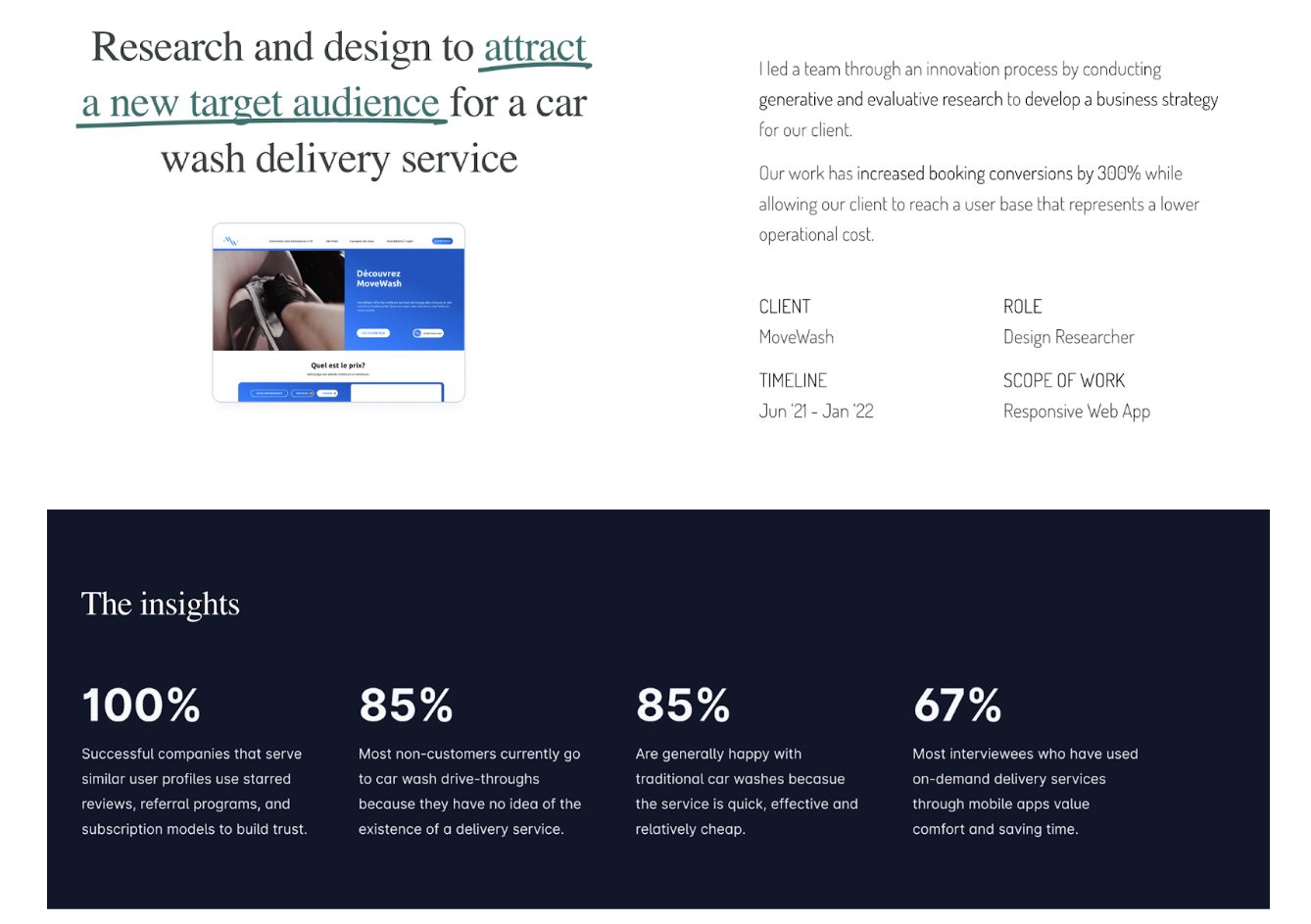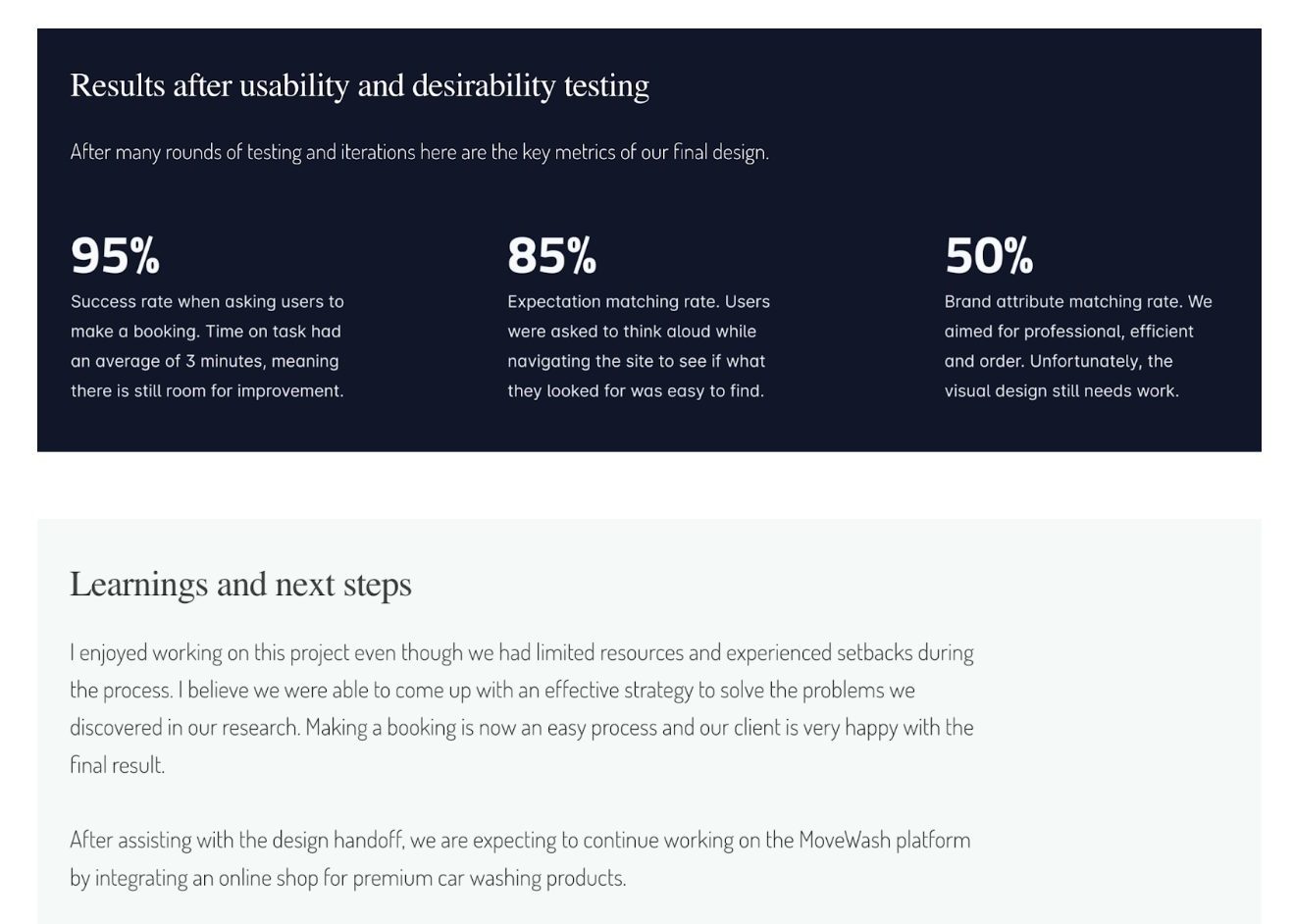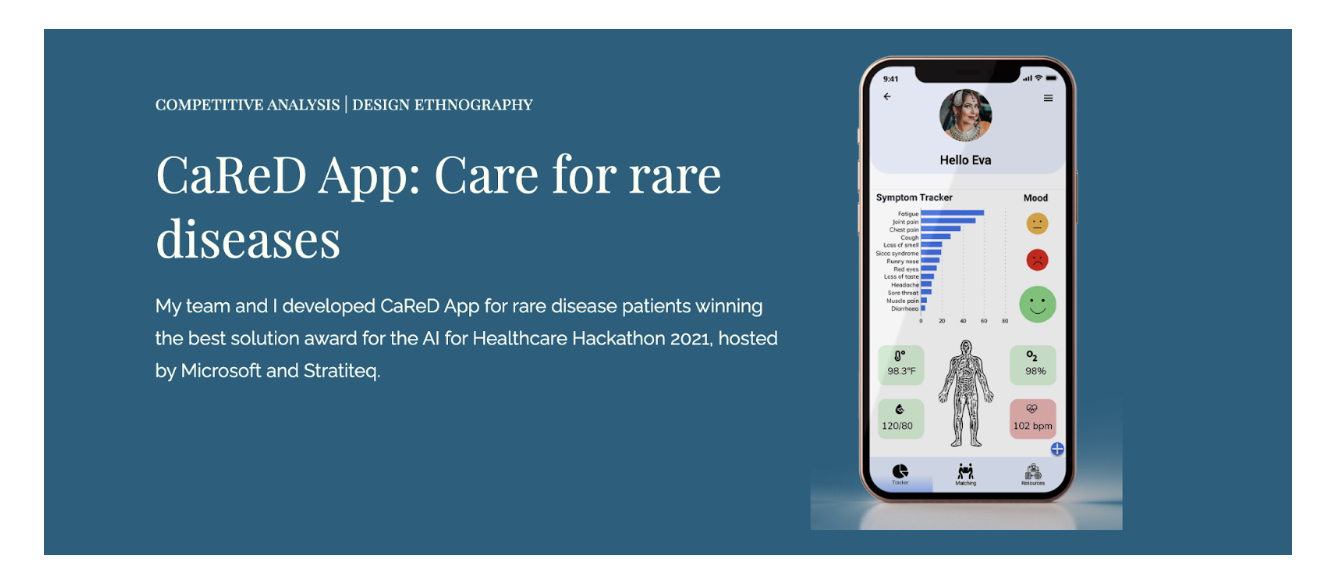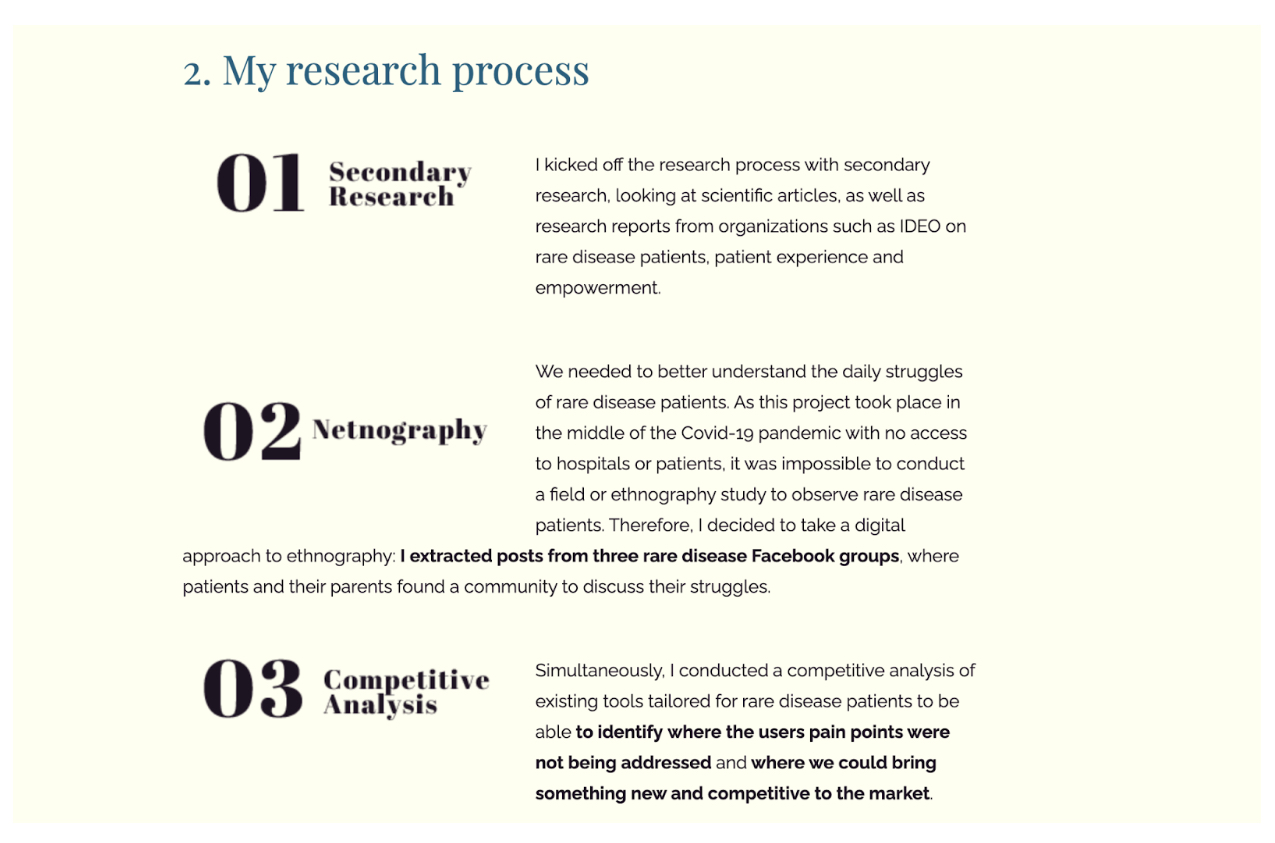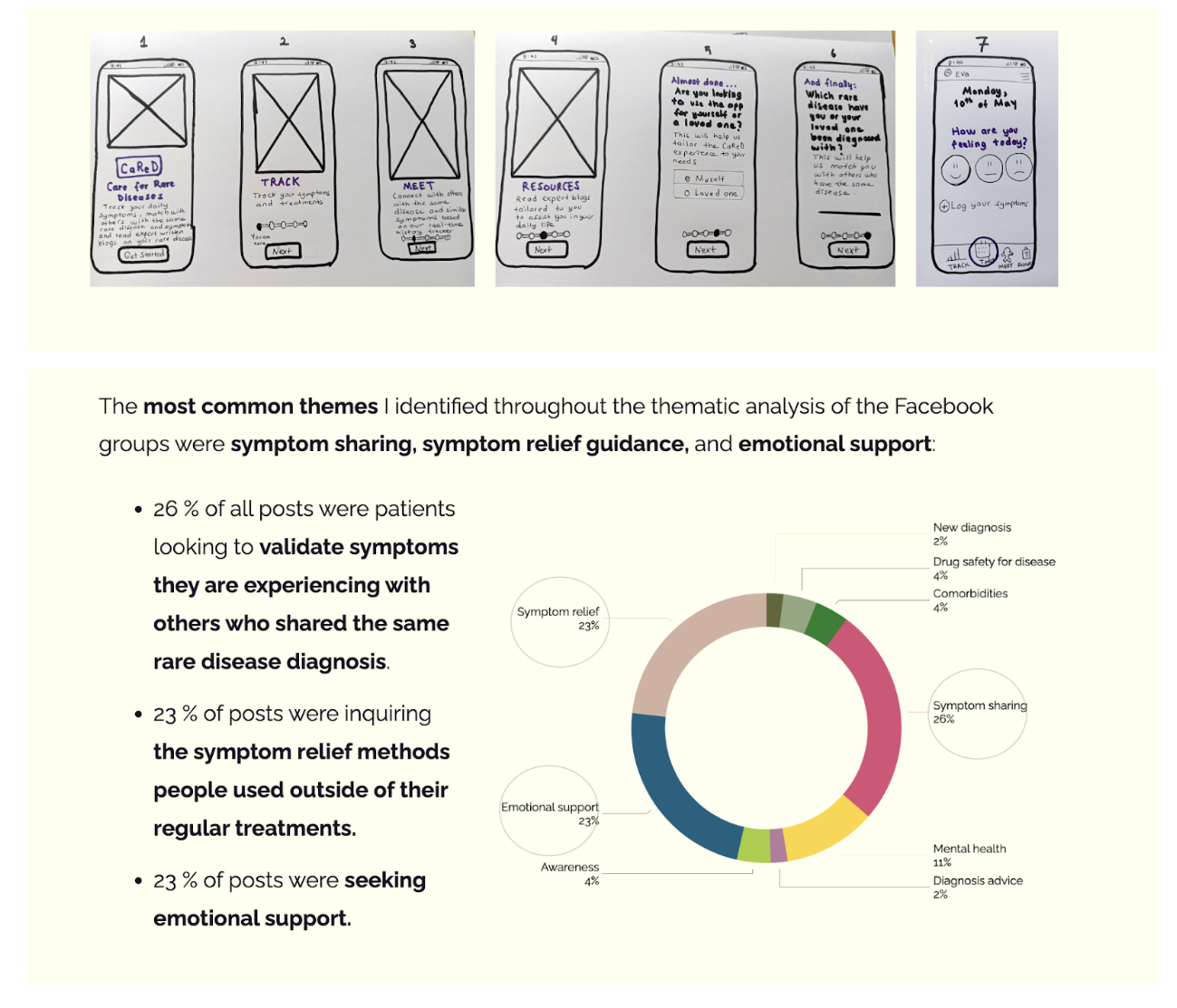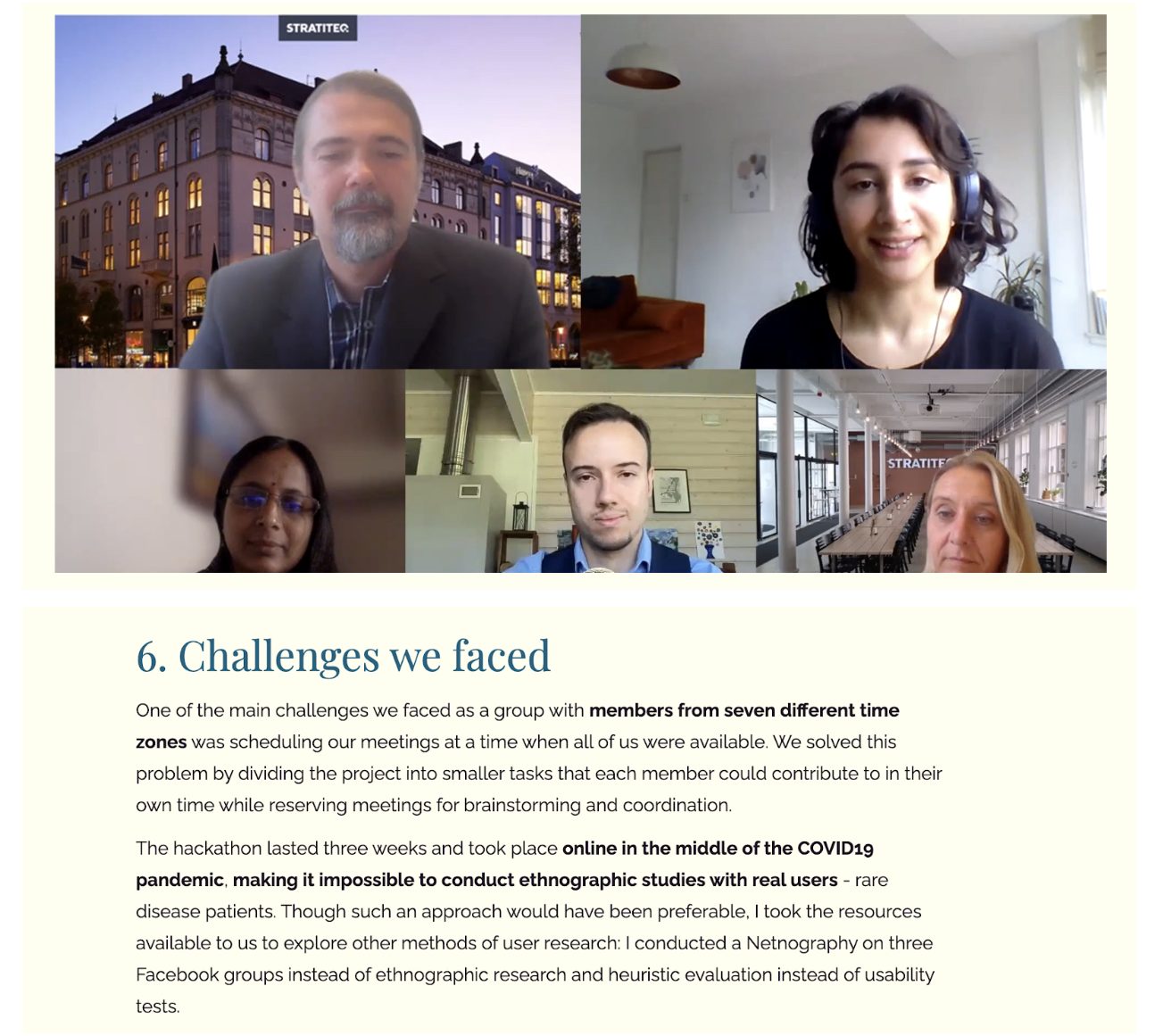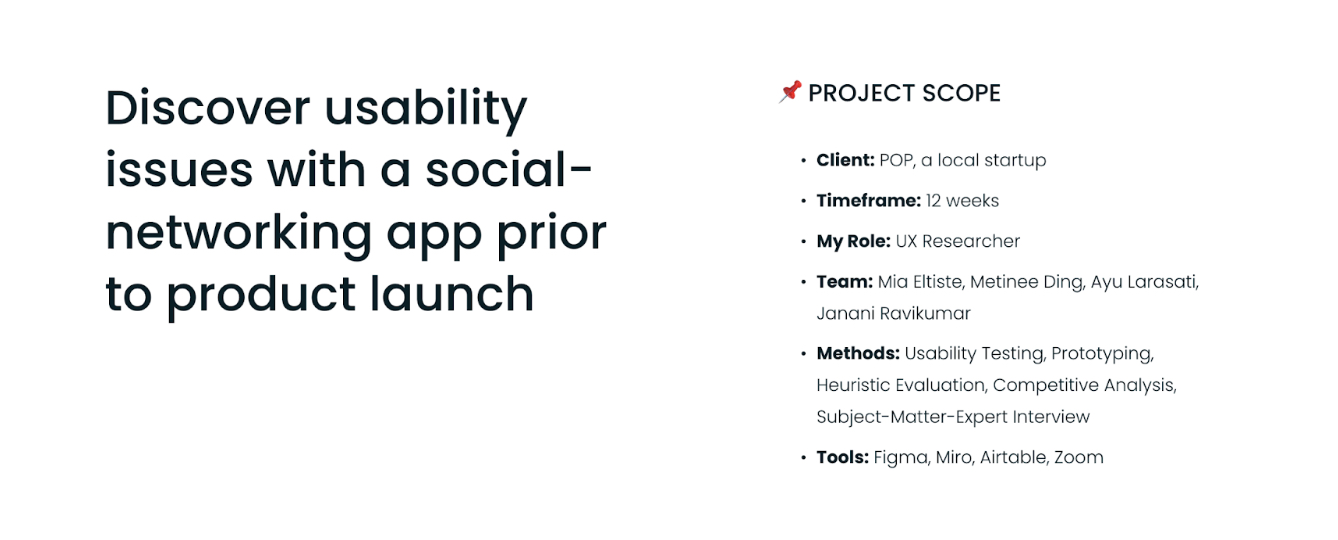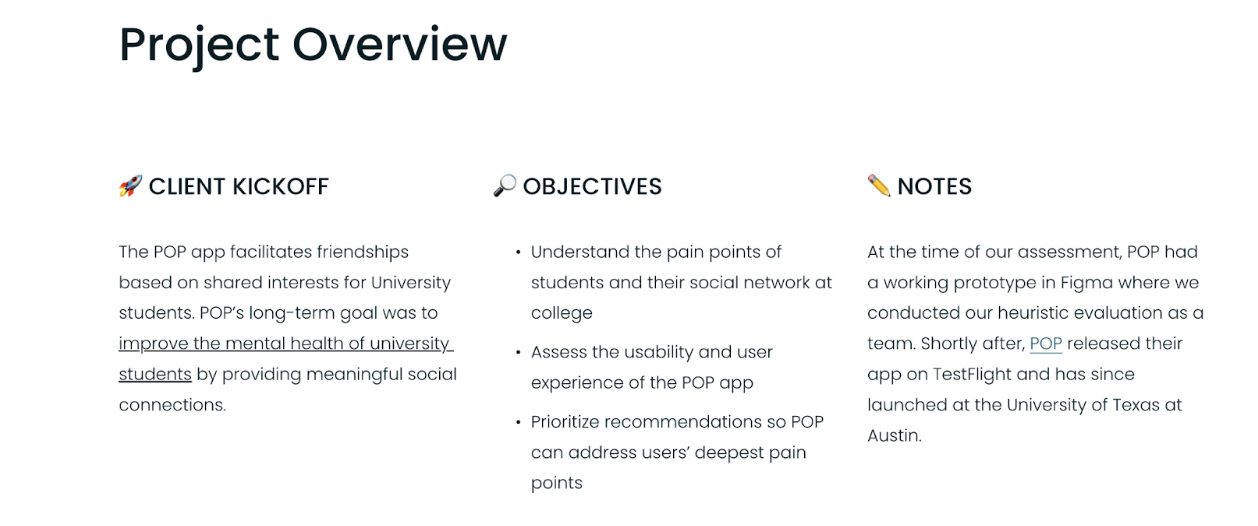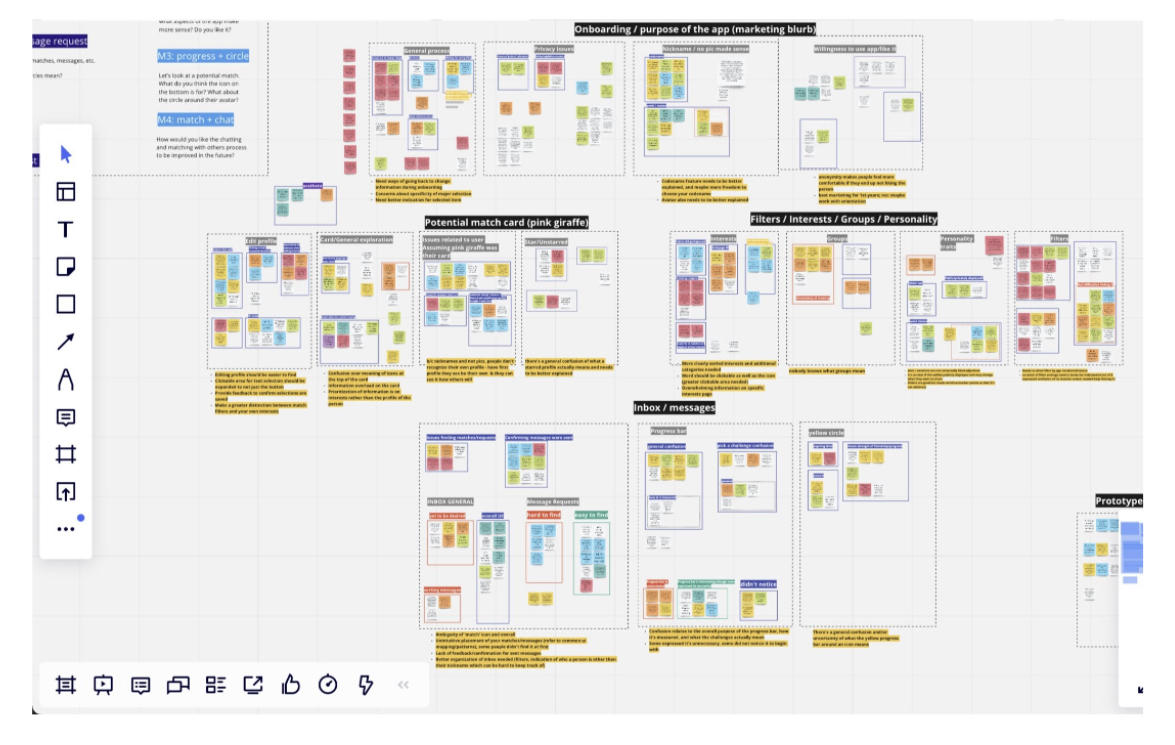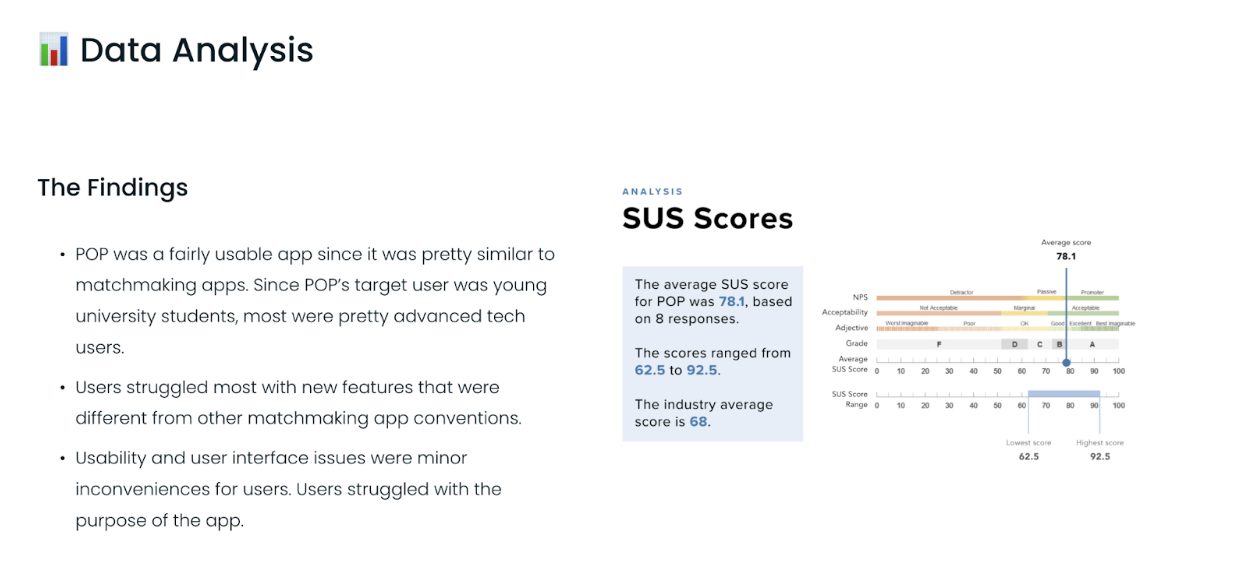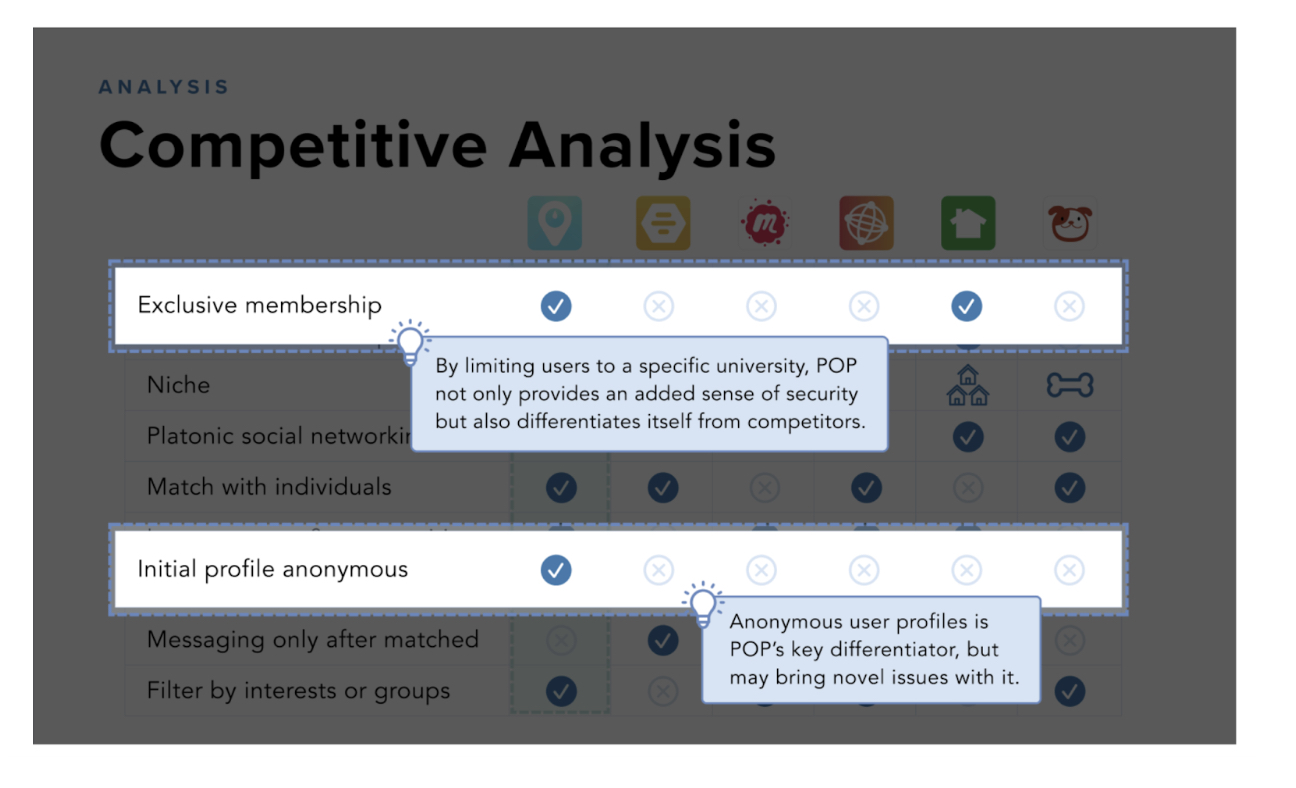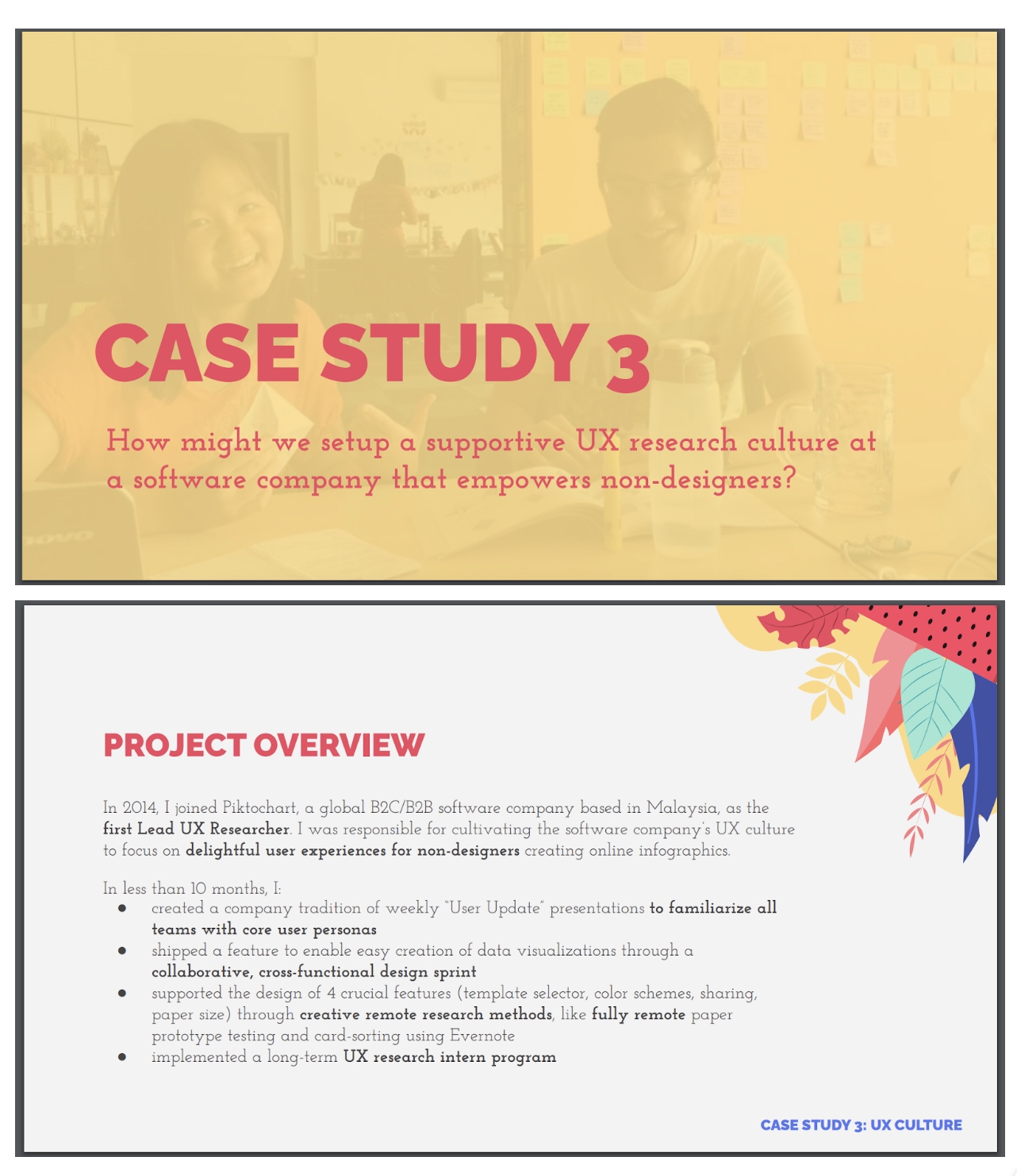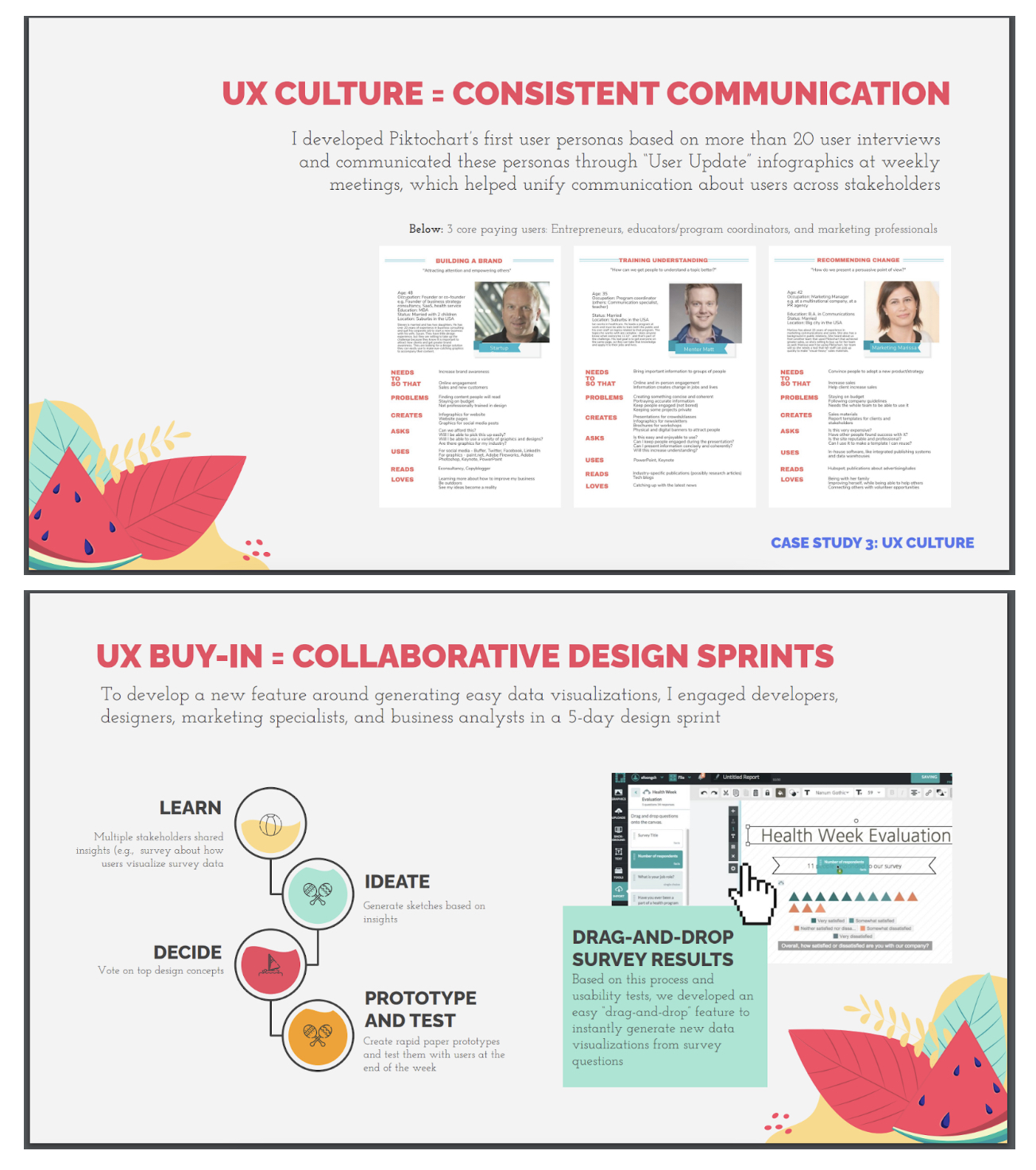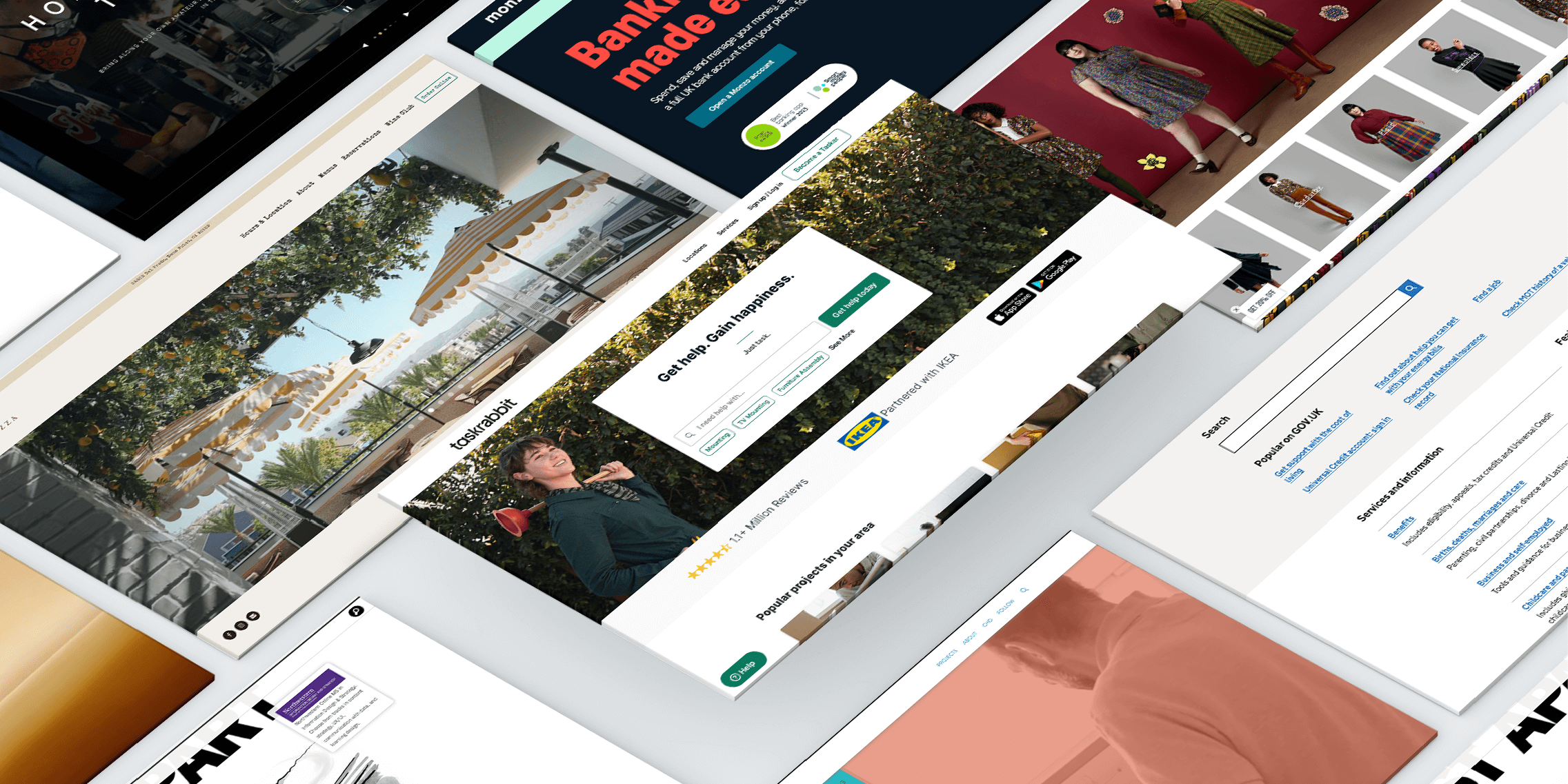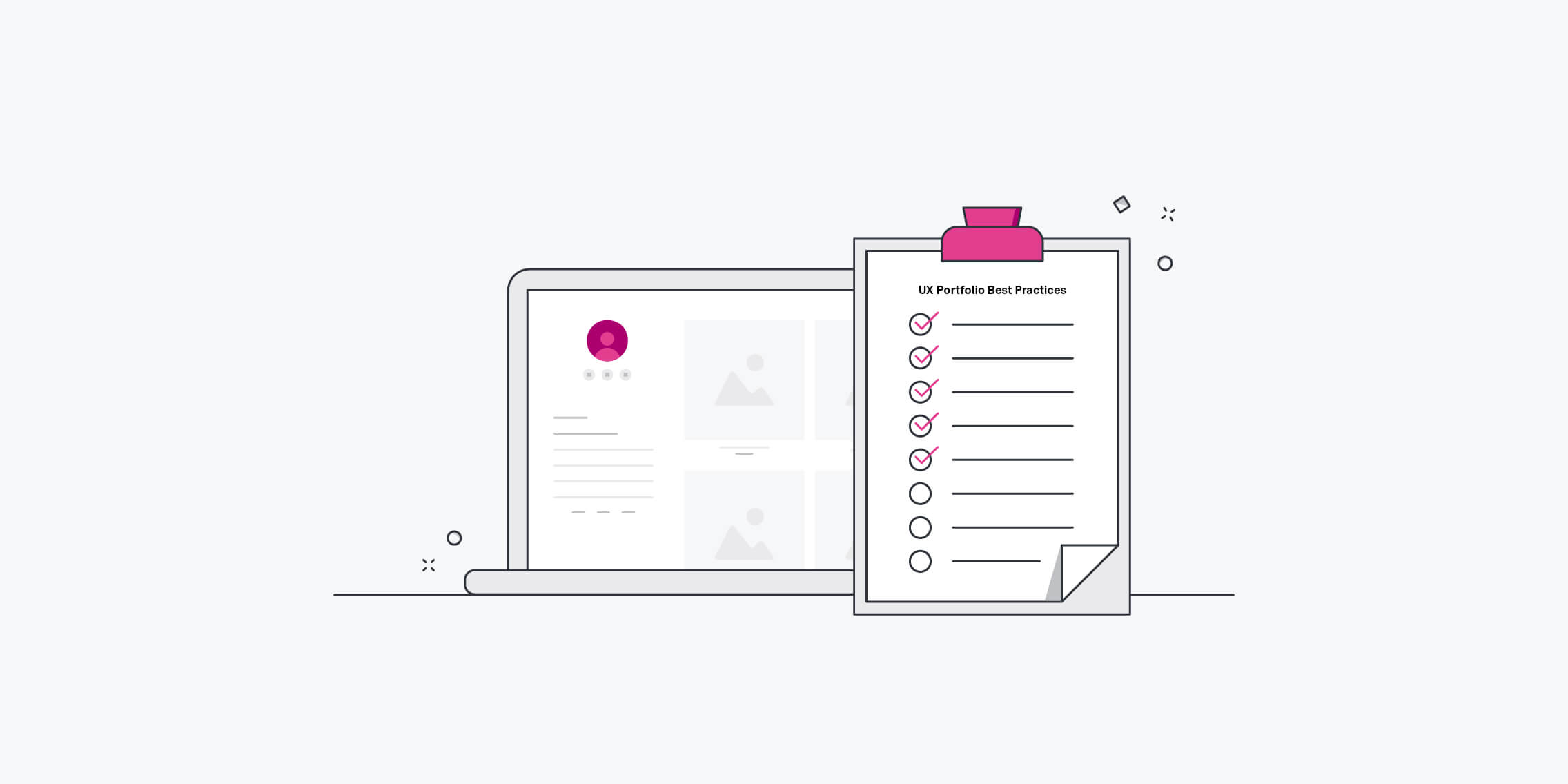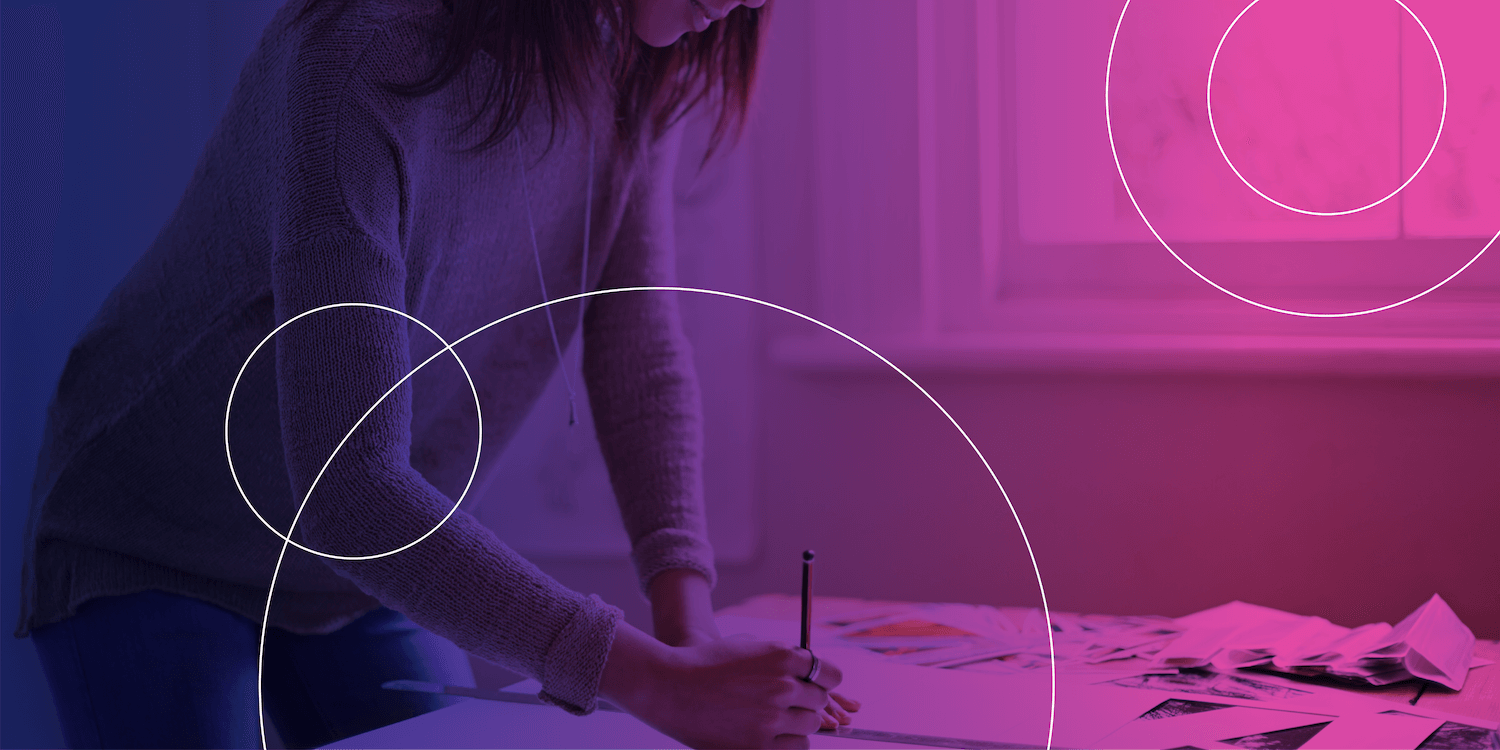If you’re working in the UX research industry (or aspiring to do so), you need a strong UX research portfolio.
Your portfolio provides proof of your skills, knowledge, and expertise, showing employers and clients exactly what you’re capable of. It’s also a crucial pillar of your personal brand—the way you present and market yourself within the industry.
Building a stellar UX research portfolio takes work. Even if you’ve got plenty of projects to showcase, knowing how to present those projects can be tricky.
How do you tell a coherent story and effectively convey the value of your work? How should you structure your UX research projects? What information should you include?
Fortunately, there are some tried-and-tested formulas you can follow—and plenty of brilliant UX researchers to take inspiration from.
In this post, we’ve compiled five awesome UX research project examples (as featured in real UX researchers’ portfolios) to inform and inspire you. For each project, we’ve highlighted key learnings you can use when building your own UX research projects and case studies.
What is a UX research portfolio and why do you need one?
User research is a crucial branch of UX and product design. It’s no longer considered just another step in the UX design process; as more and more companies recognise the importance of user research, it’s evolved into an entire discipline—and a distinct career path.
Working in UX research requires specialist skills and knowledge. UX researchers must be adept at planning different research projects, implementing qualitative and quantitative research methodologies, and analysing and interpreting research data to produce actionable insights. They must also be well-versed in user research ethics.
And, if you want to land a research-specific role, you’ll need a dedicated UX research portfolio.
A UX research portfolio showcases your expertise as a researcher. It introduces who you are, highlights your most valuable skills, and demonstrates how you approach different research tasks and projects.
The bulk of your UX research portfolio will be based on case studies. Each case study highlights an individual project, providing a detailed walk-through of your process and the impact of your work.
It doesn’t matter where you’re at in your research career; a professional portfolio is crucial for showing what you’re capable of and building your personal brand. It’s a chance to showcase your best work, prove that you’re well-versed in a variety of research methods, and ultimately to convince employers or clients that they should work with you.
Even if you’re not actively looking for work, your UX research portfolio serves as an up-to-date and ever-evolving log of your skills, experience, and accomplishments.
What to include in your UX research portfolio
A strong UX research portfolio should include:
- An “about” section or page that introduces you, the person behind the portfolio!
- A contact form and / or links to your email address, LinkedIn profile, and other professional accounts
- User research case studies that highlight specific projects you’ve worked on
If you’ve got them to hand, you can also include testimonials from previous employers or clients. However, your case studies are the real star of the show—so let’s take a look at how to structure them.
What makes for a great UX research case study?
Your UX research case studies give hiring managers a behind-the-scenes look at how you work and approach different challenges. They focus on individual projects in detail, outlining:
- Your role on the project
- The problem or challenge you set out to solve
- The step-by-step process you followed to tackle the project, including the tools and methods you used along the way
- Any challenges you came up against and how you overcame them
- Artefacts you produced (such as surveys, user personas, and data visualisations)
- The outcomes and impact of your work
- Learnings and reflections
- Actionable next steps
Each UX research case study should tell a coherent story, clearly showing what you did, how you did it, and why. The goal is to demonstrate how you apply your UX research skills to provide value—both for the end user and the business.
Now we know why you need a UX research portfolio and what to include, let’s explore existing research portfolios for inspiration.
5 UX research project examples to inspire your portfolio
In this section, we’ll showcase five UX research project examples, highlighting what they do well and what you can learn from them when creating your own portfolio.
Starting with…
1) Sahar Naderi’s aparty UX research case study
Sahar Naderi is a UX researcher and service designer based in Washington, DC. Sahar’s portfolio does a great job of highlighting the breadth of their research skills, with case studies spanning exploratory, evaluative, and generative research.
The “aparty” case study is an excellent example of how to structure a UX research project and tell a cohesive story about your work.
We love:
- The project summary at the top which clearly outlines the type of research carried out, Sahar’s role on the project, and the research objectives. This provides important context in a concise, easily-scannable format.
- The clickable menu with jump-down links. Sahar has prioritised usability and ease of navigation, like any great UX researcher would!
- The clearly labelled sections detailing each key step in the process, complete with visual proof in the form of mind maps, affinity maps, and data visualisations.
- The “Research impact” section showing exactly what Sahar’s research helped to achieve—broken down into user impact, strategic impact, and business impact.
What can we learn from Sahar Naderi’s UX research project?
Sahar Naderi’s UX research portfolio highlights several important best practices. When building out your own UX research case studies, consider:
- Including a brief project summary at the very beginning to set the scene.
- Adding a clickable menu (like you often see in blog posts) to help the reader navigate your case study.
- Featuring a key visual for each section of your case study.
- Clearly outlining the impact and value you were able to deliver, both from an end-user perspective and for the business.
View the full case study here: Sahar Naderi’s UX research portfolio.
2) Mohamad Safi’s MoveWash UX research case study
Mohamad Safi describes himself as a UX research game-changer, “sprinting alongside tech companies to help them scale by making informed design decisions that delight users.” A strong introduction which he backs up throughout his portfolio!
Mohamad’s portfolio really emphasises the link between user research, data-driven decisions, and ultimately better business—an important (but oft-overlooked) connection to make if you want to demonstrate your value as a UX researcher.
The MoveWash case study does an especially good job of communicating the business value of Mohamad’s work. Here are some project highlights:
- A high-impact headline which summarises the project and ties it to a clear business goal: “Research and design to attract a new target audience for a car wash delivery service”.
- The business impact of the project is reported upfront, right in the introduction. Before expanding on his process, Mohamad states: “Our work has increased booking conversions by 300% while allowing our client to reach a user base that represents a lower operational cost.” Increased bookings and reduced costs? Now we’re intrigued!
- Strong storytelling. Mohamad narrates the project from start to finish, crafting a logical story that sets the scene, walks through his process step-by-step, and shares how he reached certain conclusions. It’s easy to follow and allows you to envision how the project unfolded.
- Key metrics and data throughout, consistently grounding Mohamad’s work in real numbers and clearly demonstrating tangible, measurable value that came from the project.
- The case study concludes with “Learnings and next steps”, where Mohamad reflects on the project and shares how it’s expected to move forward. This highlights the continuous nature of user research!
What can we learn from Mohamad Safi’s UX research project?
When creating your UX research portfolio, don’t focus solely on outlining your process. Wherever possible, showcase the impact of your process, too—tying it to tangible outcomes and measurable data.
Here are some action points you can take from Mohamad’s UX research portfolio:
- Report on the impact of your work in the project introduction—this is what we did and this is the difference it made, in a nutshell. You can then showcase how you got there throughout the case study itself.
- Clearly frame the goals of the project from a business perspective. Rather than simply stating “Our goal was to conduct in-person interviews with five users”, explain what the client or company wanted to achieve—such as uncovering pain-points in order to boost sign-ups.
- Translate your work into clear and measurable value. Whether it’s key metrics and hard numbers or qualitative user or stakeholder feedback—include anything that demonstrates the impact of your work.
View Mohamad Safi’s work here: Mohamad Safi’s UX research portfolio.
3) Rüya Ince’s CaReD app case study
Rüya Ince is a mixed-methods UX researcher based in the Netherlands. She also describes herself as a cultural empath, an impact-driven communicator, and a storyteller with an eye for design—all great qualities that are reflected throughout her UX research portfolio.
Rüya’s CaReD app case study demonstrates the power of the passion project. Not all your portfolio case studies have to be based on real client work. Passion projects—projects you work on for fun—are just as effective when it comes to showcasing your skills.
Rüya and her team developed the CaReD app when taking part in the AI for Healthcare Hackathon 2021, hosted by Stratiteq and Microsoft. The app, which seeks to improve the patient experience for people with rare diseases, won the “best solution” award in the Empowering Patients track. Impressive!
So how do you showcase a passion project in your UX research portfolio? Here’s what we love about Rüya’s approach to her CaReD app case study:
- Clearly numbered sections outline the project in a logical order, starting with the design challenge (as set out by the hackathon), detailing the process Rüya and her team followed, and culminating in the final solution. This chronological narrative is essential for helping the reader to understand what you did and why.
- The “Challenges we faced” section. Rüya goes beyond sharing her research process to also reflect on the logistical and collaborative challenges associated with the project. And, most importantly, she outlines how she overcame those issues—demonstrating her problem-solving skills in action.
- Relevant visuals throughout. Illustrations, prototypes, data visualisations, and screenshots from team video calls help to showcase how the project evolved and give valuable behind-the-scenes insight into Rüya’s work.
What can we learn from Rüye Ince’s UX research project?
Rüya Ince’s portfolio teaches us several things about how to structure an impressive UX research case study—but also about what kinds of projects can make for great case study material. Here are some key learnings from Rüya’s CaReD app project:
- If you’re struggling to find projects to include in your research portfolio, be creative. You don’t need to wait for a real client brief or your first job to apply your research skills. Consider volunteering, taking part in hackathons, or working on a passion project—anything that requires you to solve an end-user problem through research. Then, document your work and add it to your portfolio just as you would for any other project.
- With hypothetical or passion projects, you may lack real data—but it’s still important to think about the value your work could bring if it were to be implemented. Consider including a “What’s next?” section to reflect on how your proposed solution might take shape if you were to develop it.
- In addition to specific UX research methodologies and techniques, it can be really valuable to share your approach to teamwork and collaboration in general. Rüya reflects on the challenge of scheduling team meetings across different time zones and how they worked around it. That’s a great way to show employers that you’re proactive and solution-focused!
Learn more about Rüya Ince and her work here: Rüya’s UX research portfolio.
4) Mia Eltiste’s POP app usability evaluation
Mia Eltiste is an NYC-based UX researcher with a passion for ethical design and social entrepreneurship.
Her entire portfolio stands out for its clean, clutter-free aesthetic and powerful copy—including pearls of wisdom such as “Putting the user first doesn’t put the business last” and “UX research is a fancy way to say I observe how humans interact with the world.”
Mia’s POP usability case study is no exception, presenting perhaps one of the most well-organised, well-written, and easy-to-digest case studies we’ve ever come across!
We especially love:
- The clear project summary outlining the scope of the project, Mia’s role, and the methods and tools used.
- The UX tips nestled throughout. Mia is evidently passionate about empowering others to do great work (she has a whole “Learn UX” section on her portfolio where she shares useful resources), and including UX tips within her case studies is a great way to showcase that.
- The annotated visuals. Check out the “Competitive Analysis” visual where Mia has highlighted two main points of interest and annotated them with additional information. Smart!
- The “Reflections” section which is divided into industry takeaways and personal takeaways. Mia reflects on the limitations of evaluative research within the scope of that particular project, and also shares her personal learnings.
What can we learn from Mia Eltiste’s UX research project?
If, like Mia, you want to build clear, well-structured UX research case studies, bear the following in mind:
- Clean, clutter-free design has a critical role to play when telling the story of each UX research project. Don’t underestimate the importance of white space, well-balanced text and visuals, and an easily legible font.
- In the same vein, think about how you present each piece of information. Run through your case studies with a critical eye, removing any unnecessary information and trimming the text down so that it’s skimmable and straightforward. Bullet points are your friend!
- While most UX research case studies follow a similar formula, you can still infuse a touch of individuality. For example, Mia takes the unique approach of sprinkling helpful UX tips throughout. Don’t shy away from including a little something extra if it helps to showcase who you are and how you work.
Discover more of Mia’s work: Mia Eltiste’s UX research portfolio.
5) Eureka Foong’s UX research culture case study
Eureka Foong, PhD, is a UX researcher and computer scientist specialising in equitable design and fully remote research methods.
Her UX research portfolio is available in PDF format—which can be ideal if you want to create custom versions of your portfolio to send to specific employers. It also features an incredibly interesting UX research project focusing not on a product, but on developing a research culture within a company. This is an excellent example of how research skills can be applied to all sorts of problems and challenges!
This particular case study details Eureka’s role as the first ever Lead UX Researcher at Piktochart, a software company based in Malaysia. Eureka set out to answer the following question: How might we set up a supportive UX research culture at a software company that empowers non-designers?
Here’s what we love about Eureka’s UX research culture case study:
- It’s delightfully concise—more like a presentation than a full-on case study. Eureka delivers all the essential information in an easily skimmable, digestible format.
- It presents the outcomes and value upfront. As part of the project overview, Eureka lists what she was able to achieve as a result of her research, providing useful context before elaborating on her methodology.
- It showcases how UX research skills can be applied to organisational and cultural challenges, not just to tangible products—and that such projects make for equally powerful portfolio case studies.
What can we learn from Eureka Foong’s UX research project?
Eureka’s UX research portfolio is a reminder to think outside the box. While it’s advisable to build your portfolio as a website, alternative formats can be useful for specific contexts—such as presenting your portfolio during an interview or creating a more concise, customised version of your portfolio to appeal to different audiences.
Here are some interesting lessons we can take from Eureka Foong’s UX research culture case study:
- Product design is just one of many possible use cases for your UX research skills. If you want more (and interesting) material for your portfolio, identify a societal or organisational challenge and apply your research process to come up with potential solutions.
- No matter what kind of project or challenge you’re showcasing, you still need to include tangible artefacts to demonstrate your process. Eureka may not have been designing a specific product, but she still includes personas and visualisations throughout her research case study.
- Brevity is key when presenting your UX research projects, but don’t leave out important details. Employers want to gain real insight into how you work and what you’re capable of—and sometimes that requires more extensive storytelling. A shorter PDF version (like Eureka’s) can be great for certain contexts, but it’s always worth hosting more comprehensive case studies on your portfolio website.
See more of Eureka’s work: Eureka Foong’s UX research portfolio.
Takeaways and next steps
As you can see, most UX research projects and case studies follow a similar structure. They:
- Tell a logical, cohesive story that outlines the scope of the project, walks through the researcher’s process, and shares tangible outcomes and value.
- Include both text and visuals to communicate key moments in the project.
- Usually include learnings, reflections, and takeaways.
When creating your own UX research portfolio, there’s no need to reinvent the wheel. Take inspiration from existing projects and case studies (like the ones we’ve showcased in this post) and emulate what works: clean, clutter-free design, easily digestible text, clearly labelled sections, and a good mix of text and visuals.
And remember: the goal is to demonstrate how you tackle different challenges and to showcase your user research process in action. Don’t just focus on what you did; explain why you did it, how you did it, and what happened as a result.
What next?
You can’t build a portfolio until you’ve acquired essential UX research skills and applied them to practical projects. If you’re new to user research, consider taking a professional course first.
A credible program will teach you everything you need to effectively tackle a variety of research challenges—from creating a research plan and choosing the right methods, through to analysing and communicating your research findings.
Check out the UX Design Institute’s Professional Certificate in User Research (which includes a portfolio project) or weigh up your options with the help of our UX research course comparison guide.
Already well-versed in user research and want to get started on your portfolio? These guides will help you:
- What do hiring managers look for in a UX portfolio?
- Short on experience? Here are 5 tried-and-tested ways to find projects for your portfolio
- 8 UX portfolio tips & best practices all designers should follow


